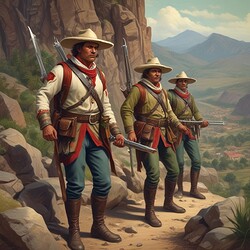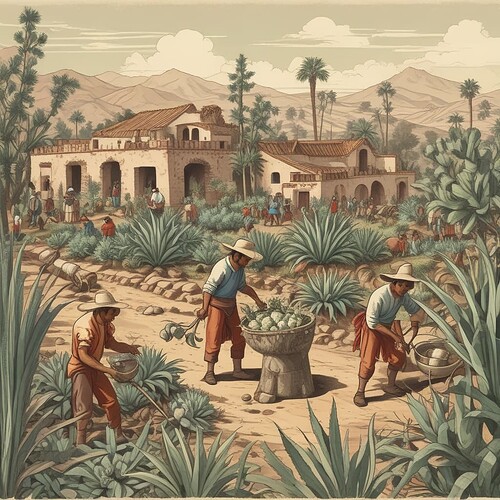I made a consultation with GTP chat, and I think that muiscas would be a good replacement for the Zapotecs, both on the maps and in the native embassy of the Incas:
"The Incas and the Muiscas did have contact, although it was limited. The Incas, who were a civilization that originated in Peru, expanded their empire northwards, reaching what is now Colombia, but they did not conquer the region of the Muiscas, which was located in central Colombia.
The Muiscas, who were a confederation of cacicazgos, maintained a certain autonomy and defended their independence against the Incas. Although there was some contact and trade between the two groups, there was no Inca conquest or dominion over the Muiscas.
In fact, when the Spanish arrived in Colombia, they found that the Muiscas maintained their own identity and culture, different from that of the Incas. The Muiscas were a society organized into cacicazgos, with a complex political and social structure, and they spoke their own language, Muysccubun.
It’s important to note that, although the Incas did not conquer the Muiscas, there was cultural and commercial influence between the two groups, and archaeological artifacts and remains have been found that suggest an exchange of goods and ideas between them."
"The Muiscas and the Incas did have an alliance at certain times. Although the Incas didn’t conquer the Muiscas, there was a period when the two groups established a political and commercial alliance.
In particular, during the reign of Inca Huayna Capac, who ruled from 1493 to 1527, an alliance was established between the Incas and the Muiscas. This alliance was based on mutual need for trade and defense against neighboring peoples.
The Muiscas, who were experts in gold and emerald production, provided these precious goods to the Incas, who in turn provided military protection and access to their trade networks. This alliance allowed the Muiscas to maintain their independence and autonomy, while the Incas gained access to valuable and strategic resources.
However, it’s important to note that this alliance was not an equal relationship, and the Incas maintained a certain level of political and cultural influence over the Muiscas. Moreover, the alliance didn’t last long, as the arrival of the Spanish in the 16th century brought about conquest and colonization of both territories."
Sources:
“The Incas and the Muiscas: A Study of the Conquest of Colombia” by John V. Murra (1946): This book is a classic in the history of the Spanish conquest of Colombia and explores the contact between the Incas and the Muiscas.
“The Muiscas and the Spanish Conquest” by Juan Friede (1963): This work is a detailed study of the Spanish conquest of Colombia and the role played by the Muiscas in that process. It includes information about the contacts between the Incas and the Muiscas.
“The Cambridge History of the Native Peoples of the Americas” by Frank Salomon and Stuart B. Schwartz (1999): This book is a general history of the indigenous peoples of America and dedicates a chapter to the history of the Incas and the Muiscas in Colombia.
“The Oxford Handbook of Mesoamerican History” by Deborah L. Nichols and Christopher A. Pool (2012): Although this book focuses on the history of Mesoamerica, it also includes information about the contact between the Incas and the Muiscas in Colombia.
“The Muiscas: A Historical Review” by Gonzalo Hernández Rodríguez (2013): This online article provides an overview of the history of the Muiscas, including their contact with the Incas and the Spanish.
It’s important to note that the information about the contact between the Incas and the Muiscas may be limited and fragmented, as many historical records from the time period were destroyed or lost. However, these authors and sources can provide a solid foundation for understanding this period of Colombian history.
Remember to always verify the credibility and accuracy of historical sources, especially when dealing with complex events and processes like the Spanish conquest of America.
"The Muiscas were a politically and economically powerful society in the Andean region of Colombia, and their influence extended through commercial and political networks with other indigenous groups in the region. Although they did not have a direct presence in the Amazon, their influence was felt in the region through the circulation of goods and ideas.
For example, it is known that the Muiscas traded with indigenous groups in the northeastern region of Colombia, such as the Taironas, who were located in the Sierra Nevada de Santa Marta. They also traded with indigenous groups in the Orinoco basin, such as the Pemon and the Piaroa. This trade allowed the Muiscas’ cultural and political influence to extend to the region.
As for the Amazon, the Muiscas did not have a direct influence in the region, as they were not present in the Amazon rainforest. However, their influence was felt in the region through the circulation of goods and ideas with other indigenous groups that were present in the Amazon."
Here are some sources that support the information I provided:
“The Cambridge History of the Native Peoples of the Americas” by Frank Salomon and Stuart B. Schwartz (1999) - This book is a general history of the indigenous peoples of America and dedicates a chapter to the history of the Muiscas in Colombia.
“The Muiscas and the Spanish Conquest” by Juan Friede (1963) - This work is a detailed study of the Spanish conquest of Colombia and the role played by the Muiscas in that process.
“The Tairona: Chiefs of the Sierra Nevada de Santa Marta” by Reichel-Dolmatoff, G. (1953) - This book is an anthropological study of the Tairona ethnicity, which is located in the Sierra Nevada de Santa Marta in Colombia.
“The Indigenous Peoples of the Orinoco Basin” by Fernando Omar Morales (2013) - This article is a study of the indigenous peoples who inhabit the Orinoco basin, including the Pemon and the Piaroa.
“The Muiscas: A Historical Review” by Gonzalo Hernández Rodríguez (2013) - This article is a historical review of the Muiscas and their influence in the Andean region of Colombia.


